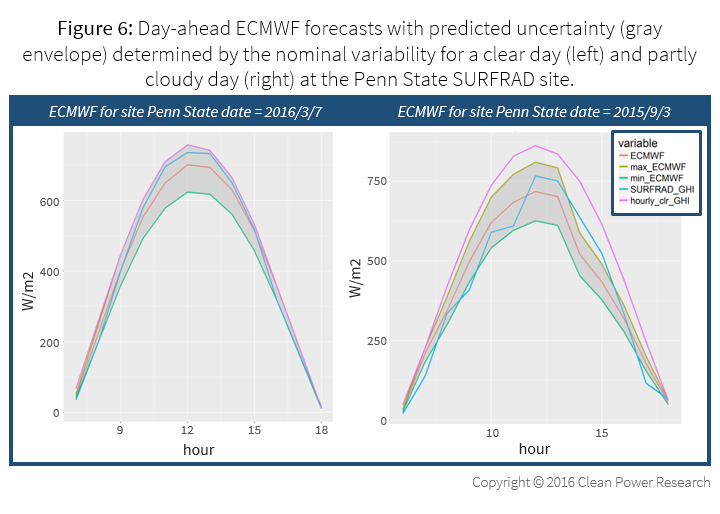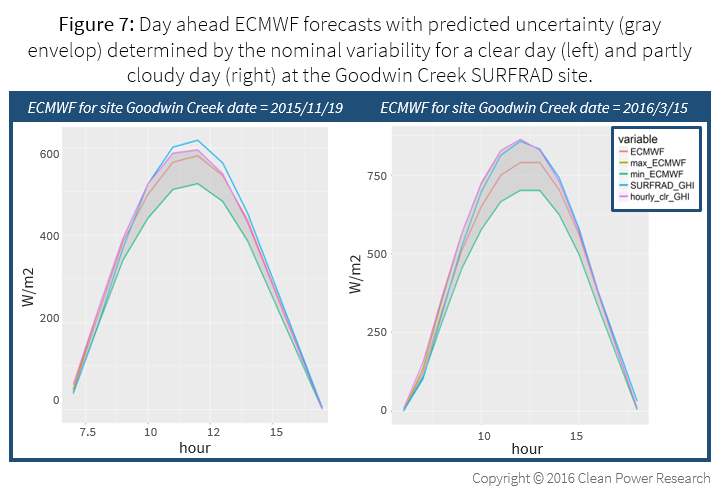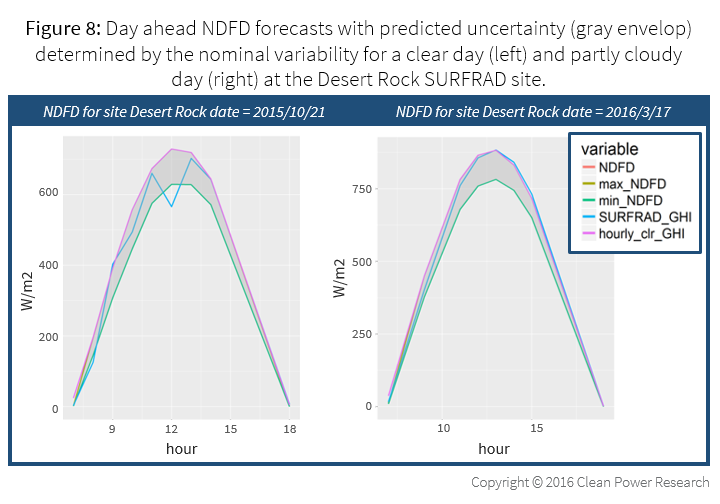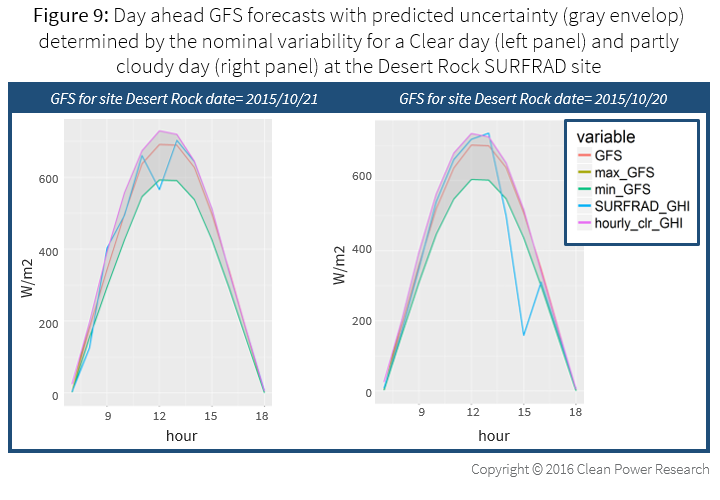Solar resource variability is an unavoidable natural characteristic that impacts solar power forecasting. However, its impact on forecast uncertainty can be reduced by providing information on predictive uncertainty, along with deterministic forecast values. Having this information can help utilities, independent power producers and grid operators minimize the risk associated with the decision making process for grid management in a day-ahead energy market.
Solar resource variability
The characterization of the solar resource is often calculated in terms of magnitude, for example, identifying how much solar energy is available at an area of interest over a specific time period. However, a complete characterization of solar resource should include information on the temporal and spatial variability of the resource over time, whether it’s on the scale of seconds or decades. Both temporal and spatial characteristics of the solar resource are the result of variations in the amount and types of clouds. Figure 1 shows unavoidable spatial and temporal solar resource variability, for the same day at different NOAA SURFRAD stations across the U.S.

In an earlier blog post, we discussed how solar variability may impact the work of utilities and grid operators and provided an example of how we can use our historical SolarAnywhere® Data to quantify that variability. In this post, we’ll elaborate on recent results that validate how this approach can be applied for any solar generator across the U.S.
The growing solar industry and its challenges
As the solar industry continues to grow, the need to systematically integrate solar energy is becoming increasingly significant. According to a report by the US Energy Information Administration (EIA), projections for U.S. electricity growth from wind and solar generation are due to a strong push from state and federal agencies, which are implementing policies to provide subsidies and establish renewable portfolio standards. For example, EIA expects renewable sources to constitute 25% of the increase in total generating capacity across the electric power sector between 2013 and 2018.
A recent article from The Guardian reported that U.S. solar power hit an all-time megawatt installed capacity in 2016, partly due to the wave of federal and state policies as well as positive economics in the industry, both in United States and most countries. This increase in the growth of solar energy presents challenges due to the variability of solar power and brings with it the potential for grid instability.
System operators use day-ahead load forecasts to help schedule the amount of energy needed for each hour of the next day. Therefore, providing system operators with an accurate day-ahead solar energy forecast and information on the forecast uncertainty will help them make early decisions about how much electricity will be needed from other, non-solar sources. The variability and uncertainty in solar power, however, are different from traditional, dispatchable generation resources and can be difficult to integrate into standard system operating procedures
For example, the passing of clouds makes it difficult to rely on the day-ahead forecast for scheduling purposes with the same confidence as traditional energy sources, which are available at any time of the day. The National Renewable Energy Laboratory’s (NREL) recent study shows that integrating 25% of solar power penetration in ISO-NE with day ahead and four hours ahead forecasts reduces net generation costs by 22.9%. However, if system operators or grid managers don’t consider solar power forecasts the reduction in net generation cost will only be 12.3% (due to only the increase in penetration) which would result in either the power system experiencing over-commitment of generation or a much higher solar power curtailment. Therefore, improving solar power forecasts and incorporating forecast uncertainty will increase the value of forecasts, leading to improved decision making in resource allocations and grid stability.
A future is coming where enough people will be generating solar energy on their rooftops to significantly increase utilities’ solar share of energy sources. This creates the potential for a huge ramp rate which could destabilize the local electricity grid. Therefore, accurate forecasts of how and when this will occur are essential to maintaining a functional system. Let’s take a look at one approach that we’ve developed and continue to advance at Clean Power Research.
Resource variability characterization model
Our research goal is to improve solar energy predictability and uncertainty quantification to minimize the risk associated with resource allocation and help improve the decision making process for stakeholders. Recently, we came up with a state-of-the-art resource variability characterization model. The model is based on the clear sky index, referred to as “Kt”, which is an indicator of the transparency of the atmosphere to the incoming solar radiation.
Here we demonstrate how SolarAnywhere solar resource data is effective at studying solar resource variability (through a metric called Nominal Variability) and how it can be used to predict forecast uncertainty. A detailed explanation of Kt and nominal variability can be found in our previous post. There are a couple of reasons why satellite data (Figure 2, left) is preferred to ground data (Figure 2, right) for resource variability and solar forecast uncertainty prediction applications.
- Ground-based measurement stations are very unevenly distributed and have limited historical data.
- Widely varying standards of calibration, maintenance procedures and historical measurement periods exist between the entities—be they governmental, non-profit or commercial—responsible for ground measurement stations.
- As the distance from a solar measuring station increases, the uncertainty of interpolated irradiation values increases.

Calculating the daily Kt value from SolarAnywhere shows a strong similarity to doing so with quality ground data for the same location, as shown in Figure 3.

Therefore, historical SolarAnywhere data can be used as a reliable proxy for ground data for solar resource variability characterization. This is a useful tool for solar project developers to understand the resource variability at any given point on earth for their respective project locations and make a better risk assessment. In addition to characterizing the solar resource at a given location using the satellite-based nominal variability model, we also took the model a step further to use it for day-ahead solar forecast uncertainty prediction.
Quantifying solar forecast uncertainty
Quantifying the variability associated with day-ahead solar power generation forecasts is essential for successful integration of solar power into the grid. These uncertainties can be appropriately quantified as probabilistic (the chance of a given forecast value to happen) rather than deterministic (an absolute single forecast value to happen).
We are introducing a new strategy of calculating confidence intervals to quantify uncertainty estimation of day-ahead solar power forecasts obtained from the NWP based deterministic forecasts. This particular combination of deterministic forecast value and solar resource variability model derived from historical SolarAnywhere data is the first time Clean Power Research has applied such a technique for forecast uncertainty quantification. The results show that such techniques can be used to improve the value of the solar forecast across several locations. The NWP forecast models for which the technique is tested are:
- European Center for Medium Range Weather forecast (ECMWF)
- Global Forecast System (GFS)
- National Digital Forecast Database (NDFD)
Before applying the solar resource variability model to determine the forecast uncertainty, we investigated if the deterministic forecast performance is a function of the weather condition, by classifying the solar forecast values into different daily clear sky index values (daily Kt). The higher the values of the daily Kt, the clearer the weather. Daily Kt of 1 corresponds to a clear sky day and daily Kt value of 0 corresponds to a complete overcast condition.
Figure 4a shows scatter plots of an ECMWF forecast with respect to SUFRAD stations irradiance values for days with daily Kt values between 0.4 to 0.7 (days dominated by partly cloudy conditions) and Figure 4b shows the scatter plot for days with daily Kt values greater than 0.7 (mostly clear days). The scatter plot for partly cloudy days shows that the forecast performance is not so great for such days. However, for days with mostly clear sky conditions the forecast performs very well, with very few scattered points beyond the 1 to 1 line (450). The same results have been seen for GFS and NDFD forecast models that the forecast are better during clear sky conditions and depart from the measured data when it is partly cloudy.

 We have also looked at solar forecast bias values (forecast minus observation) for different weather conditions in Figure 5. It is clear from the figures that higher daily Kt (clear or near clear sky condition) values are associated with a tighter forecast bias distribution around zero values, which means the forecasted value is very close to the actual value. Therefore, it is evident that we can characterize the forecast uncertainty using some function of atmospheric transparency metric (in this case daily Kt), which is a proxy for solar resource variability (Nominal variability – as shown Figure 3).
We have also looked at solar forecast bias values (forecast minus observation) for different weather conditions in Figure 5. It is clear from the figures that higher daily Kt (clear or near clear sky condition) values are associated with a tighter forecast bias distribution around zero values, which means the forecasted value is very close to the actual value. Therefore, it is evident that we can characterize the forecast uncertainty using some function of atmospheric transparency metric (in this case daily Kt), which is a proxy for solar resource variability (Nominal variability – as shown Figure 3).

We then fitted the nominal variability models developed using historical SolarAnywhere data to the deterministic forecast and created a 68% confidence interval for the forecast uncertainty. Figure 6 shows the probabilistic forecast for ECMWF for two days with different weather systems. The Figure to the left shows the day with relatively clear sky condition and the figure to the right is for partly cloudy condition for Penn State SURFRAD station, with humid continental climate (Humid with severe winter and warm summer conditions).

We can clearly see that the uncertainty envelope for the clear day is relatively tighter and that the uncertainty envelope for the partly cloudy day is wider. However, in both cases the measured data is within an envelope. We can predict with 100% accuracy that the forecast is within the shaded region indicating a 68% confidence interval (CI). As the CI increases the probability of accurately predicting the forecast increases. In this case we are trying to make the CI tighter so that we can build accurate forecast models.
Figure 7 shows the ECMWF predicted forecast uncertainty for Goodwin Creek, MS, which has a humid subtropical climate. Similarly, the Goodwin Creek forecast uncertainty was also predicted with a very good accuracy. There are cases when the measured irradiance value can go beyond the clear sky irradiance value due to cloud edge enhancements, which is shown in Figure 8 left panel. However, even in those days the upper bound of the envelop is close to the forecast and it minimizes forecast error compared to the actual deterministic forecast.

Figure 8 shows NDFD forecast for Desert Rock, which has a dry arid (desert) climate. The figure shows similar results as the previous forecast cases. On the left panel of the figure we see that a passing small scale cumulus cloud is creating a dip trough (hole) in the measured data, which is missed by the deterministic forecast. However, the lower bound of the forecast envelope is close to the measured value and would have completely captured the measured data had the CI been 95%.

Figure 9 shows the predictive uncertainty for the GFS forecast at Desert Rock SUFRAD station. We can see the effect of a deep small cloud during mid-day and in the afternoon for this location on these two different days.

Take Away
As we move into scenarios with higher penetrations of PV on the grid, more reliable and effective forecasts will help minimize potential causes of grid instability. A nominal variability model developed using high-quality, long-term historical satellite data can be used to:
- characterize solar resource variability at any given location
- better understand the resource variability
- help with site selection by filtering sites with minimum resource variability
- provide predicted uncertainty with day-ahead solar forecasts to make better decisions for reserve generation resource allocations
The next step for us is to apply this approach to our forecasting service in SolarAnywhere. We invite our users to let us know where this type of application can be useful in your operation and how you would incorporate this added level of intelligence into your decision making process. To follow up – contact us at SolarAnywhereSupport@cleanpower.com.
